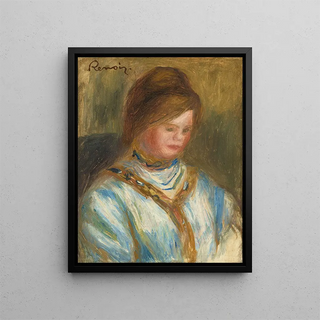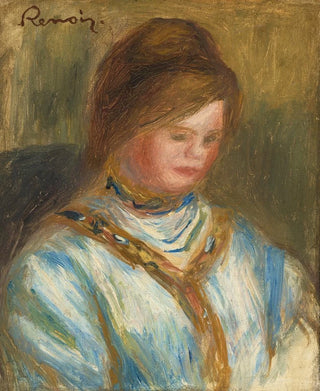Art print | Woman in a blue bodice - Pierre-Auguste Renoir


View from behind

Frame (optional)
Femme au corsage bleu - Pierre-Auguste Renoir – Captivating Introduction
The canvas "Femme au corsage bleu" by Pierre-Auguste Renoir embodies the very essence of Impressionism, an artistic movement that revolutionized painting conventions in the 19th century. This masterpiece, created in 1876, depicts an elegant woman dressed in a vibrant blue dress, seemingly capturing the light and energy of a fleeting moment. The viewer's gaze is drawn to the softness of her facial features and the fluidity of her gestures, as if Renoir aimed to immortalize ephemeral beauty in a constantly evolving world. The art print of this work not only allows appreciation of the artist's technical virtuosity but also invites you into the intimate and poetic universe he masterfully created.
Style and uniqueness of the work
Renoir's style is distinguished by his bold use of colors and his ability to reproduce light in a spectacular manner. In "Femme au corsage bleu," shades of blue intertwine harmoniously with touches of white and pink, offering a striking contrast that captures the eye. The brushwork, both fluid and lively, gives the composition a sense of movement and vitality. Delicate shadows and bright highlights blend to create an impression of depth, while the blurred background emphasizes the presence of the central figure. This approach, characteristic of Renoir, underscores the importance of emotion and sensation in art, transforming each canvas into an immersive visual experience.
The artist and his influence
Pierre-Auguste Renoir, an emblematic figure of Impressionism, left an indelible mark on the art world. Born in 1841 in Limoges, he initially worked as an artisan before fully dedicating himself to painting. Influenced by contemporaries such as Monet and Degas, Renoir developed a unique style that celebrates the beauty of everyday life and human relationships. His works, often populated with scenes of leisure, festivities, and portraits, reveal a particular sensitivity to emotions and light. Renoir's impact extends far beyond his era; he opened the

Matte finish

View from behind

Frame (optional)
Femme au corsage bleu - Pierre-Auguste Renoir – Captivating Introduction
The canvas "Femme au corsage bleu" by Pierre-Auguste Renoir embodies the very essence of Impressionism, an artistic movement that revolutionized painting conventions in the 19th century. This masterpiece, created in 1876, depicts an elegant woman dressed in a vibrant blue dress, seemingly capturing the light and energy of a fleeting moment. The viewer's gaze is drawn to the softness of her facial features and the fluidity of her gestures, as if Renoir aimed to immortalize ephemeral beauty in a constantly evolving world. The art print of this work not only allows appreciation of the artist's technical virtuosity but also invites you into the intimate and poetic universe he masterfully created.
Style and uniqueness of the work
Renoir's style is distinguished by his bold use of colors and his ability to reproduce light in a spectacular manner. In "Femme au corsage bleu," shades of blue intertwine harmoniously with touches of white and pink, offering a striking contrast that captures the eye. The brushwork, both fluid and lively, gives the composition a sense of movement and vitality. Delicate shadows and bright highlights blend to create an impression of depth, while the blurred background emphasizes the presence of the central figure. This approach, characteristic of Renoir, underscores the importance of emotion and sensation in art, transforming each canvas into an immersive visual experience.
The artist and his influence
Pierre-Auguste Renoir, an emblematic figure of Impressionism, left an indelible mark on the art world. Born in 1841 in Limoges, he initially worked as an artisan before fully dedicating himself to painting. Influenced by contemporaries such as Monet and Degas, Renoir developed a unique style that celebrates the beauty of everyday life and human relationships. His works, often populated with scenes of leisure, festivities, and portraits, reveal a particular sensitivity to emotions and light. Renoir's impact extends far beyond his era; he opened the






